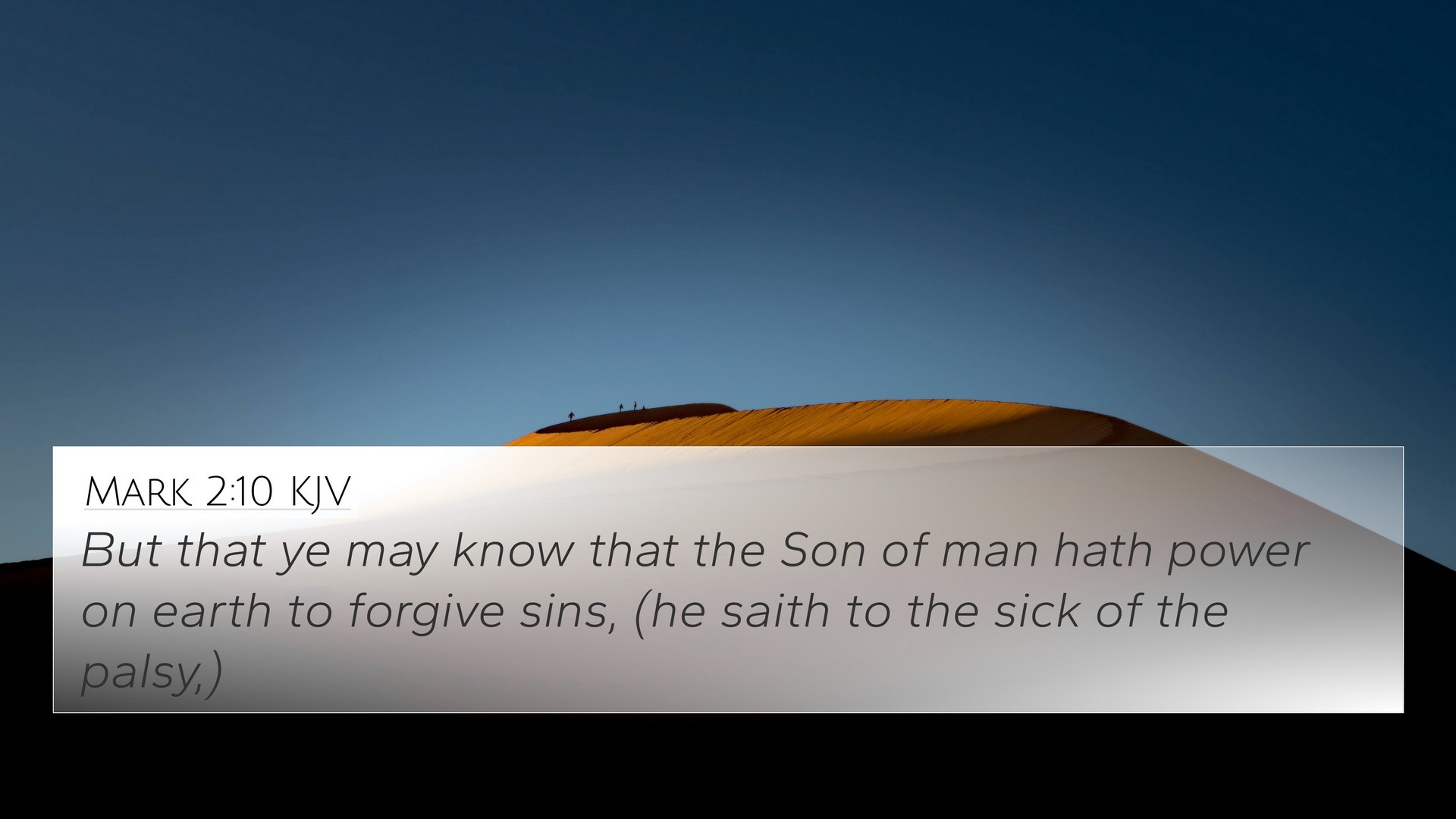Old Testament
Genesis Exodus Leviticus Numbers Deuteronomy Joshua Judges Ruth 1 Samuel 2 Samuel 1 Kings 2 Kings 1 Chronicles 2 Chronicles Ezra Nehemiah Esther Job Psalms Proverbs Ecclesiastes Song of Solomon Isaiah Jeremiah Lamentations Ezekiel Daniel Hosea Joel Amos Obadiah Jonah Micah Nahum Habakkuk Zephaniah Haggai Zechariah MalachiMark 2:10 Similar Verses
Mark 2:10 Cross References
But that ye may know that the Son of man hath power on earth to forgive sins, (he saith to the sick of the palsy,)
Uncover the Rich Themes and Topics of This Bible Verse
Listed below are the Bible themes associated with Mark 2:10. We invite you to explore each theme to gain deeper insights into the Scriptures.
Mark 2:10 Cross Reference Verses
This section features a detailed cross-reference designed to enrich your understanding of the Scriptures. Below, you will find carefully selected verses that echo the themes and teachings related to Mark 2:10 KJV. Click on any image to explore detailed analyses of related Bible verses and uncover deeper theological insights.

Daniel 7:13 (KJV) »
I saw in the night visions, and, behold, one like the Son of man came with the clouds of heaven, and came to the Ancient of days, and they brought him near before him.

Matthew 9:6 (KJV) »
But that ye may know that the Son of man hath power on earth to forgive sins, (then saith he to the sick of the palsy,) Arise, take up thy bed, and go unto thine house.

Matthew 16:13 (KJV) »
When Jesus came into the coasts of Caesarea Philippi, he asked his disciples, saying, Whom do men say that I the Son of man am?

John 5:20 (KJV) »
For the Father loveth the Son, and sheweth him all things that himself doeth: and he will shew him greater works than these, that ye may marvel.

Acts 5:31 (KJV) »
Him hath God exalted with his right hand to be a Prince and a Saviour, for to give repentance to Israel, and forgiveness of sins.

1 Timothy 1:13 (KJV) »
Who was before a blasphemer, and a persecutor, and injurious: but I obtained mercy, because I did it ignorantly in unbelief.
Mark 2:10 Verse Analysis and Similar Verses
Understanding Mark 2:10
Mark 2:10: "But that you may know that the Son of Man has power on earth to forgive sins," He said to the paralytic.
Summary of Meaning
This verse is pivotal in revealing the authority of Jesus Christ as the Son of Man, highlighting both His divine power and His role in the forgiveness of sins. Matthew Henry, Albert Barnes, and Adam Clarke provide complementary insights that enrich our understanding of this profound statement.
Insight from Public Domain Commentaries
-
Matthew Henry's Commentary
Matthew Henry emphasizes the significance of Jesus' authority, asserting that the title "Son of Man" reflects both His humanity and His divine mission. By claiming the power to forgive sins, Jesus confirms His identity as the Messiah and showcases the central theme of redemption throughout the Gospels.
-
Albert Barnes' Notes
Albert Barnes elaborates on the concept of forgiveness, explaining that sin is a primary ailment of the soul, and only Jesus possesses the authority to heal spiritually. He notes that this ability to forgive sins not only validates Jesus’ mission but also bridges the gap between humanity and God, offering hope and restoration.
-
Adam Clarke's Commentary
Adam Clarke reflects on the social and theological implications of Jesus’ statement, suggesting that to forgive sins is a prerogative reserved for God alone. He posits that by asserting His power in this area, Jesus challenges the established religious norms and invites believers to reflect on His divine nature and grace.
Thematic Connections
This verse can be interlinked with several other biblical scriptures, illustrating the deep thematic resonance in the Bible regarding sin, healing, and authority:
- Isaiah 53:5: "But He was wounded for our transgressions..." - This verse prefigures the sacrificial nature of Christ's mission.
- John 1:29: "Behold! The Lamb of God who takes away the sin of the world!" - Attests to Jesus' role as the ultimate sacrifice for sin.
- Luke 5:24: "But that you may know that the Son of Man has power on earth to forgive sins..." - A parallel statement that enhances the understanding of Jesus' authority.
- Matthew 9:6: "But that you may know that the Son of Man has authority on earth to forgive sins..." - Also emphasizes the intimate connection between Jesus’ healing and His authority to forgive.
- Romans 5:8: "But God shows his love for us in that while we were still sinners, Christ died for us." - Highlights the depth of God's love related to forgiveness.
- 1 John 1:9: "If we confess our sins, he is faithful and just to forgive us our sins..." - Illustrates the relational aspect of confession and forgiveness.
- Matthew 11:28: "Come to me, all you who labor and are heavy laden, and I will give you rest." - Invites those burdened by sin to receive rest and forgiveness through Him.
Importance of Cross-Referencing
Cross-referencing Bible verses enhances our understanding of scriptural themes and enriches personal study. Various tools and guides can facilitate this exploration:
- Bible Concordance: A useful resource for locating thematic verses.
- Bible Cross-Reference Guide: Helps in identifying connections between different scriptures.
- Cross-Reference Bible Study: Methodologies that promote deeper biblical inquiry through identified links.
How to Use Bible Cross-References
Understanding how verses relate can be critical for theological studies, sermon preparation, or personal reflection. Here are some practical methods:
- Identifying Connections: Look for references that echo similar themes or teachings.
- Comparative Study: Analyze verses from the Old and New Testament that speak about forgiveness.
- Linking Bible Scriptures: Use parallel accounts in the Gospels to gain multifaceted insights.
Conclusion
Mark 2:10 serves as a powerful affirmation of Jesus’ authority to forgive sins, a vital attribute of His divine nature that resonates throughout the biblical narrative. Through careful study and cross-references, believers can deepen their understanding of this truth and its implications for faith and practice.


